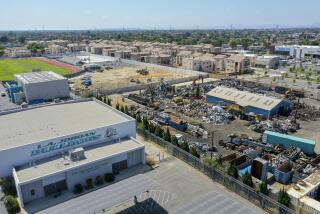Rockwell Lists 12 Radioactive Releases at Lab in Last 20 Years
- Share via
Minor releases of radioactive material have accidentally occurred 12 times during the last 20 years at the Santa Susana Field Laboratory west of Chatsworth, according to a report Rockwell International submitted Monday to the U.S. Nuclear Regulatory Commission.
Rockwell filed the report in response to an order from NRC Administrative Law Judge Peter Bloch, who asked the company for a list of all spills, fires or other events since 1969 that involved radioactive releases at the test site in the Simi Hills, where Rockwell has done nuclear work for the federal government for more than 30 years.
In an affidavit filed with the report, a Rockwell official said the 12 incidents “plus releases prior to 1969 account for all areas” at Santa Susana that have been contaminated by radioactive material. The majority of nuclear work at the site occurred before 1969, and thus was not covered by Bloch’s request.
Among the most recent events was an October, 1986, fire that occurred while a nuclear fuel rod was being sawed apart in the heavily shielded “hot lab” at Santa Susana. Rockwell said a small amount of radioactivity was released to high efficiency air filters at the hot lab.
The list also included the loss in April, 1986, of a small quantity of strontium-90 in a sealed radiation source, which Rockwell said was “probably disposed as radioactive waste” inadvertently during cleanup work.
One release was listed as “current”: the leakage of radioactive tritium into ground water at Building 59, which formerly housed a nuclear reactor. The low tritium readings were found by an Environmental Protection Agency survey team last summer following repeated statements by Rockwell that no evidence of radioactive pollution of ground water existed at the site.
Rockwell had not tested ground water near the building for tritium, and has been criticized by the EPA and others for failing to adequately monitor for radioactivity.
Bloch, who will rule on Rockwell’s request to renew the nuclear materials license for Santa Susana’s “hot lab,” first asked Rockwell in September for a list of all radioactive releases since 1969 “producing anything other than trivial results that are very unlikely to cause any detriment to anyone’s health.”
Rockwell responded that there had been no events which met that description, since no releases had occurred during the 20-year period that exceeded NRC limits.
Then, in a second order dated Oct. 4, Bloch requested a list of all releases, no matter how trivial.
Of the 12 events cited in its report, Rockwell said it had erred in failing to disclose one in its response to Bloch’s original request.
This was a 1977 incident in which more than 2,000 gallons of water contaminated by radioactivity leaked from a storage pit. Rockwell said soils contaminated by the leak were cleaned up, but did not say if ground water was contaminated.
Rockwell officials refused to answer questions Monday or comment on the report. “The list stands on its own,” said company spokesman Paul Sewell.
Jerome Raskin, a Northridge resident and intervenor in the license case, said he got his copy of the report Monday and had not had time to study it. He said the radioactive releases seemed small, but questioned the completeness of Rockwell’s records.
Bloch would not comment on the list, but said Rockwell’s performance is of less importance now that the firm has greatly scaled back its license request.
Rockwell had sought a 10-year renewal of its NRC license in hopes of attracting new Department of Energy contracts to declad nuclear fuel--work that involves taking apart fuel rods and removing radioactive uranium and plutonium for use at U.S. weapons production sites.
But with almost no current business for the hot lab and vigorous community opposition, Rockwell announced two weeks ago that it wanted only a one-year license renewal to complete a few current projects and decommission the hot lab.
Santa Susana, operated by Rockwell’s Rocketdyne division in Canoga Park, was once a major nuclear testing and development site for the DOE and its predecessor, the Atomic Energy Commission. From the mid-1950s to the early 1980s, 16 small nuclear reactors operated there, and fuel fabrication and decladding work was also performed up to 1986. Since then, most of the nuclear work has involved cleaning up contamination from past activity.
A DOE report released last May said chemical and radioactive pollution exists in several areas of the site, but mostly at low levels. Officials with the DOE and state and federal environmental agencies have since said the contamination poses no immediate threat to neighbors.
More to Read
Sign up for Essential California
The most important California stories and recommendations in your inbox every morning.
You may occasionally receive promotional content from the Los Angeles Times.













